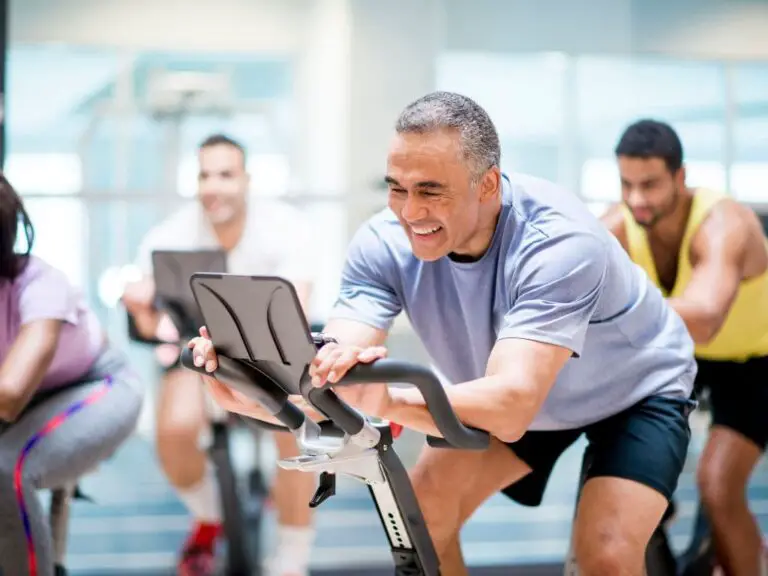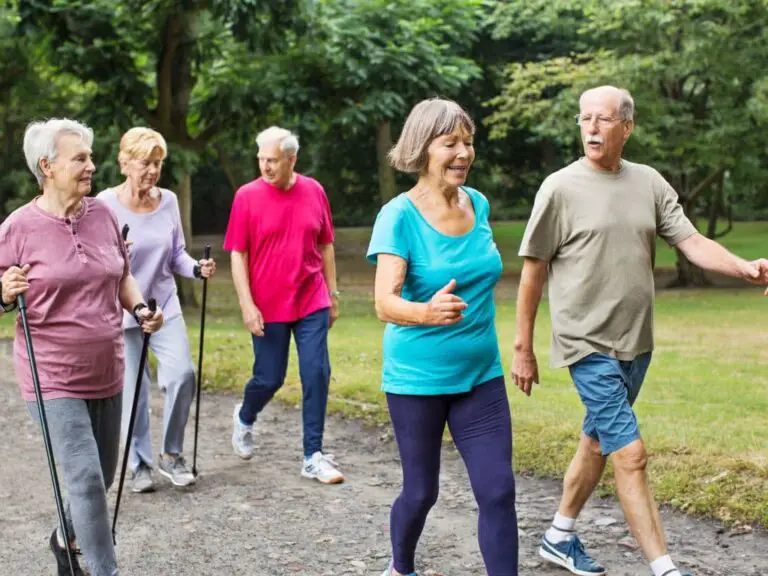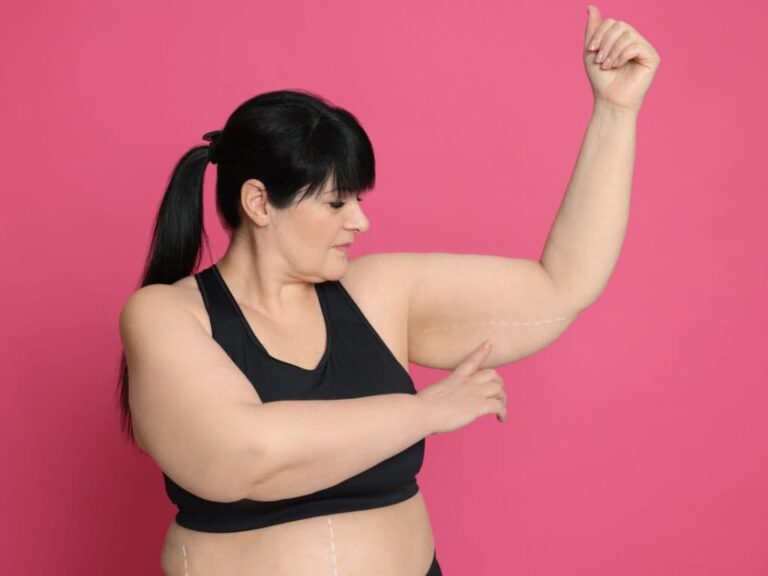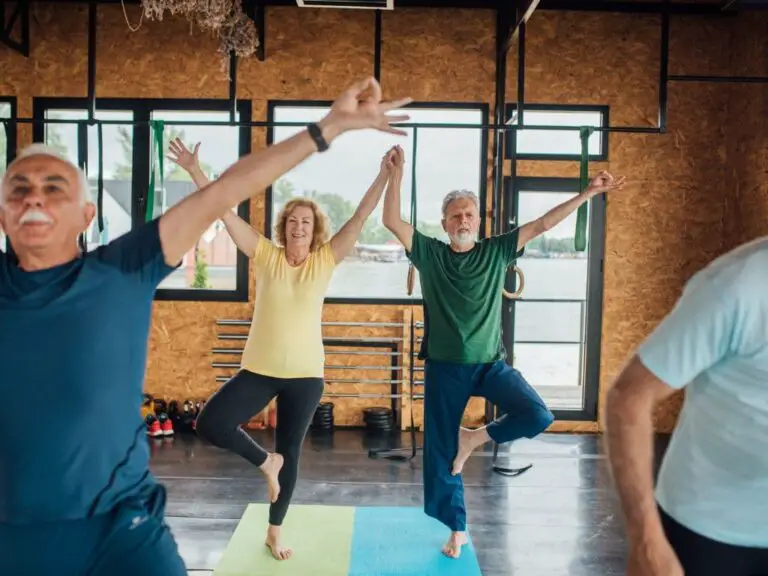Can You Lose Weight Doing Chair Exercises?
Are you a senior looking for an effective way to lose weight without the intensity of traditional workouts? Chair exercises might be your answer. Research shows that these low-impact activities can help burn calories, build muscle and boost metabolism.
Dive into this article to discover how chair exercises can support your weight loss journey, as we unravel exercise types, benefits and precautions for seniors. Don’t let age slow you down! Let’s get moving while seated!
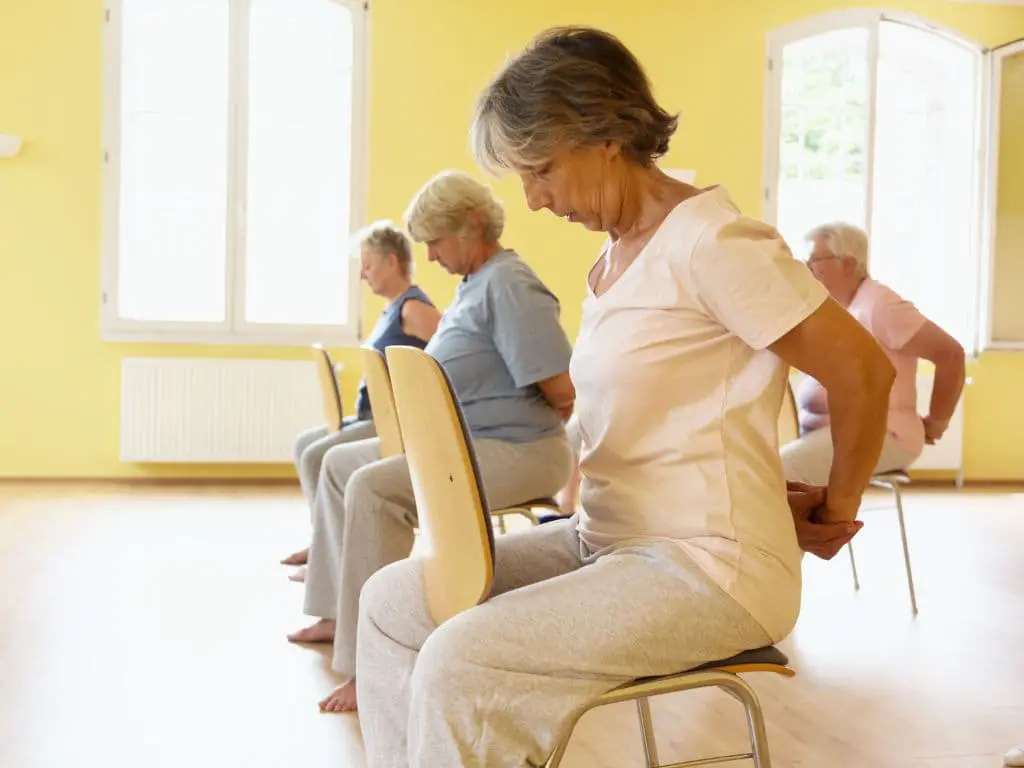
What are Chair Exercises?
Chair exercises are fitness activities you can perform while sitting or using a chair for support. They are particularly popular among seniors as they offer a safe and effective way to maintain strength, flexibility, balance, and mobility.
From leg raises to ballerina squats, there’s a range of movements that target various muscle groups. You can even add equipment like resistance bands and ankle weights to ramp up the intensity.
A unique advantage of chair exercises is their accessibility — you can do them at home with minimal space required! This makes these workouts perfect for individuals who have difficulty getting out—an ideal option for those with limited mobility or balance problems related to conditions like arthritis or osteoporosis.
Benefits of Chair Exercises
Chair exercises can provide a multitude of benefits, particularly for seniors. One significant benefit is the potential to increase cardiorespiratory fitness. With consistent practice, these exercises can help boost lung and heart function which in turn improves overall health.
Another compelling advantage of chair exercises is their ability to improve strength and flexibility. These workouts do wonders in enhancing muscle power – vital for maintaining balance and preventing falls among older adults.
They also allow greater joint mobility contributing positively towards flexibility.
Dealing with stress becomes simpler through chair exercises as they are empirical ways to reduce anxiety. The movements involved trigger the release of endorphins, also known as “feel-good” hormones, which promote feelings of happiness and decrease feelings of stress.
Lastly, one cannot discount how these seated workouts aid in increasing energy levels and metabolism rates. An elevated metabolic rate hints at more calories burnt even during rest periods! This makes weight management easier while improving overall vitality.
Each session done from the comfort of your own home brings you one step closer to better health without adding extra strain on your body.
Increase cardiorespiratory fitness
Incorporating chair exercises into your daily routine can boost cardiorespiratory fitness. Engaging in aerobic movement, these exercises can elevate both heart and breathing rates.
Similar to high-intensity workouts, chair exercises effectively burn fat and expend calories leading to weight loss.
Continuing this practice will help improve overall fitness levels, especially beneficial for seniors who might find traditional forms of exercise challenging. Improved cardiorespiratory health is one of the many benefits that come with regular chair exercises.
This means a healthier heart and lungs which are vital for maintaining good mobility and balance as you age. The best part? These benefits are accessible right from the comfort of your home!
Improve flexibility and strength
Chair exercises are a fantastic way for seniors to improve flexibility and strength. Regularly engaging in seated exercises can help to keep your muscles flexible, strong, and healthy, maintaining a range of motion in your joints.
By incorporating stretching into your chair exercise routine, you can enhance your overall fitness level and reduce the risk of injury. Strengthening exercises using resistance bands or bodyweight movements will also contribute to building muscle strength, improving balance, and increasing mobility.
With consistent practice, you’ll notice an increase in your ability to move comfortably and perform daily activities with ease.
Reduce stress and anxiety
Exercise is not only beneficial for physical health, but it can also have a positive impact on mental well-being. Chair exercises are a great way for seniors to reduce stress and anxiety.
When we exercise, our bodies release endorphins, which are natural chemicals that help us feel good and reduce feelings of stress. Additionally, regular exercise can improve sleep quality and boost mood by reducing the production of stress hormones.
So whether you’re doing chair yoga or engaging in seated cardio exercises, incorporating physical activity into your routine can be a powerful tool in managing stress and anxiety.
Increase energy levels
Chair exercises can help increase your energy levels, giving you a boost of vitality and stamina throughout the day. Regular physical activity has been shown to improve sleep quality, allowing you to wake up feeling refreshed and energized.
Additionally, exercise increases blood flow and oxygen circulation in your body, delivering nutrients and removing waste more efficiently. This enhanced circulation helps combat fatigue and leaves you feeling more alert and revitalized.
So if you’re looking for a natural way to increase your energy levels, incorporating chair exercises into your routine may just be the answer.
Increase metabolism
Chair exercises can help to increase metabolism, which is essential for weight loss in seniors. By engaging in regular physical activity, such as cardio exercises and strength training, you can boost your metabolic rate and burn more calories throughout the day.
In fact, studies have shown that resistance training can elevate muscle metabolism for hours after exercising, even when sitting! This means that by incorporating chair exercises into your routine, you’ll not only build muscle strength and improve balance but also promote a faster metabolism to support your weight loss goals.
So get moving with chair exercises and rev up your metabolism in a safe and effective way!
How Chair Cardio Can Help You Lose Weight
Chair cardio exercises are a great way for seniors to lose weight and improve their overall health. These exercises can burn calories, increase your metabolism, and help you shed those extra pounds.
In fact, a 32-minute session of chair exercises can help most people burn anywhere from 120 to 250 calories. That’s not all – if you want an even greater calorie burn, you can incorporate weights or resistance bands into your routine.
Chair cardio exercises can be just as effective as traditional cardiovascular workouts for burning calories and aiding in weight loss. So why not give it a try?.
How many calories can you burn doing chair exercises?
The number of calories you can burn while doing chair exercises largely depends on the type and intensity of the exercise. On average, you can burn about 100 calories by doing chair exercises for a half hour.
| Type of Chair Exercise | Approximate Calories Burned per 30 minutes |
| Chair Leg Lifts | 70-100 |
| Chair Push-ups | 100-130 |
| Chair Yoga | 80-110 |
| Chair Zumba | 100-150 |
| Chair Boxing | 130-180 |
Remember, chair-based fidgeting can also increase energy expenditure by approximately 20-30% without increasing heart rate. Therefore, even if you’re not doing formal exercises, just moving around in your chair can contribute to calorie burn and weight loss.
It’s important to note that these figures are approximate and can vary based on factors like your weight, metabolism, and the intensity at which you perform the exercises. The key to weight loss with chair exercises is consistency and gradually increasing the duration and intensity of your workouts.
How to Get Started with Chair Exercises
To get started with chair exercises, follow these steps:
- Determine your fitness level and goals.
- Choose exercises that are suitable for your body and fitness level.
- Set a routine and schedule for your chair exercise sessions.
- Focus on proper technique and form to prevent injuries.
- Start with simple exercises and gradually increase the intensity as you become more comfortable.
- Incorporate a variety of exercises to target different muscle groups and keep your workouts interesting.
- Listen to your body and take breaks if you feel fatigued or experience any discomfort.
- Consult with a medical professional if you have any health concerns or pre – existing conditions before starting a new exercise program.
Determine your fitness level and goals
To get started with chair exercises, it’s important to determine your fitness level and goals. Knowing where you’re starting from and what you want to achieve can help tailor a workout routine that is safe and effective for you.
Consider factors such as your overall health, any existing medical conditions or injuries, and your current level of physical activity. If you’re unsure about your fitness level or have specific concerns, it may be helpful to consult with a healthcare professional before beginning an exercise program.
By taking the time to assess your fitness level and set clear goals, you’ll be better equipped to choose the right exercises and make progress towards achieving weight loss.
Choose exercises suitable for your body
Find exercises that are suitable for your body and fitness level. It’s important to choose movements that you can comfortably perform without strain or pain. By selecting exercises tailored to your abilities, you can minimize the risk of injury and maximize the benefits of chair workouts.
Consider talking to a healthcare professional or certified fitness instructor who can help create an exercise plan appropriate for you. Remember, everyone is different, so finding exercises that work for your body will help ensure a safe and effective workout routine.
Set a routine
Setting a routine is crucial when it comes to incorporating chair exercises into your weight loss journey. By establishing a consistent schedule, you can ensure that you are dedicating time to exercise regularly, which is key for achieving your fitness goals.
Whether it’s designating specific days and times or integrating chair exercises into your daily routine, having a set schedule will help you stay committed and motivated. Plus, following a routine allows your body to adapt and improve over time, leading to better results in terms of weight loss and overall fitness.
So make sure to carve out dedicated time each day or week for chair exercises – your body will thank you!
Focus on technique and form
Proper technique and form are essential when doing chair exercises for weight loss. By focusing on these aspects, you can maximize the benefits of your workout while minimizing the risk of injury.
Pay attention to your body alignment and posture during each exercise. Engage the targeted muscles, breathe deeply, and maintain a controlled movement throughout. This will help you get the most out of each repetition and ensure that you are working the intended muscle groups effectively.
So remember, take your time, be mindful of your movements, and always prioritize good technique and form in order to achieve optimal results from your chair workouts.
What Are Some of the Best Chair Exercises for Weight Loss?
Chair exercises can be a great way for seniors to lose weight and improve their overall fitness. Here are some of the best chair exercises for weight loss:
- Squats: Sit on the edge of the chair with your feet shoulder-width apart. Stand up, pushing through your heels, and then lower back down.
- Lunges: Stand behind the chair, holding onto it for support. Take a big step forward with one foot and lower your body down until both knees are bent at a 90-degree angle. Push back up to standing and repeat with the other leg.
- Abdominal exercises: Sit on the chair with your feet flat on the floor. Lean back slightly and engage your core muscles. Lift one knee towards your chest, rotating your torso towards that knee. Repeat with the other knee.
- Cardio exercises: Try marching in place while sitting on the chair by lifting one knee up at a time. You can also do seated jumping jacks by extending your arms out to the sides while tapping each foot out to the side alternately.
Squats
Squats are a great exercise for seniors to incorporate into their workout routine. They can help build strength in the lower body and core muscles, which is important for maintaining balance and stability.
Squats also have the added benefit of boosting calorie burn, making them a valuable tool for weight loss. In fact, building muscle mass through squats can increase your calorie burn even when you’re at rest.
So not only will squats strengthen your legs, back, and core, but they can also contribute to burning more calories throughout the day. Whether you choose to do bodyweight squats or add weights for extra challenge, incorporating squats into your exercise routine can have significant benefits for both physical fitness and weight loss goals.
Lunges
Lunges are a fantastic exercise for seniors looking to lose weight and tone their lower body. By targeting the large muscle groups in the legs, such as the quadriceps, hamstrings, and glutes, lunges can help build lean muscle while reducing body fat.
This not only improves strength but also increases metabolism, contributing to weight loss goals. Additionally, lunges are effective in toning the buttocks and shaping them into the desired form.
Whether you choose to do stationary lunges or walking lunges, incorporating this exercise into your routine can lead to great results in terms of weight management and overall fitness.
Abdominal exercises
Regular and correct seated crunches can effectively target the lower and upper abs. These exercises can help strengthen and tone your abdominal muscles, contributing to achieving a flat belly.
By engaging your core muscles during these exercises, you can also improve your posture and stability. Adding abdominal exercises to your chair workout routine is a great way for seniors to work on their core strength without putting unnecessary strain on their backs or joints.
Cardio exercises
Cardio exercises, also known as cardiovascular exercises or aerobic exercises, are an essential part of any fitness routine. These exercises get your heart rate up and increase your breathing rate, which helps to improve your cardiovascular fitness.
Engaging in regular cardio exercises can have numerous benefits for seniors. It can help you burn calories, strengthen your heart and lungs, boost your energy levels, and even reduce stress and anxiety.
Whether it’s brisk walking, cycling on a stationary bike, or using an elliptical machine, there are plenty of ways to incorporate cardio into your chair exercise routine.
In fact, studies have shown that weight-bearing cardio exercises such as dancing or playing tennis can also improve bone health by strengthening the muscles around the bones. So don’t underestimate the power of cardio when it comes to losing weight and improving overall fitness.
Other Ways to Lose Weight Doing Chair Exercises
Chair exercises offer a variety of ways to lose weight and improve fitness. Here are some other effective methods you can try:
- Use resistance bands: Incorporating resistance bands into your chair exercises can add extra challenge and help build muscle strength.
- Add ankle weights: Strapping on ankle weights while performing chair exercises increases resistance, making your muscles work harder and burn more calories.
- Increase intensity: Gradually increase the intensity of your chair workouts by adding more repetitions, increasing the speed or range of motion, or incorporating intervals of higher intensity exercises.
- Work out for a longer period of time: Extend the duration of your chair exercise sessions to maximize calorie burn and promote weight loss.
Use resistance bands
Resistance bands can be a great addition to your chair exercise routine if you want to lose weight. These bands add resistance to your movements, making them more challenging and helping to burn more calories.
In fact, research has shown that incorporating resistance band training into your regular exercise routine can positively affect physical functioning and overall well-being. By pairing resistance band exercises with a consistent calorie deficit, you can increase the effectiveness of your workouts and work towards your weight loss goals.
Plus, using resistance bands engages stabilizer muscles, giving you an extra challenge while building strength. So don’t forget to grab those bands and add some intensity to your chair workouts!
Use ankle weights
Using ankle weights during chair exercises can be a great way for seniors to enhance their weight loss efforts and improve overall health. The added resistance provided by the ankle weights helps to increase the intensity of your workouts, leading to improved calorie burning and increased stamina.
Ankle weights are particularly effective when used during abdominal exercises, as they make these workouts more challenging and help you achieve better results. Additionally, wearing ankle weights while swimming can strengthen your knee and ankle joints, while walking with them can improve strength and burn even more calories.
So if you’re looking to boost your weight loss efforts, consider incorporating ankle weights into your chair exercise routine.
Increase intensity
To maximize the benefits of chair exercises and promote weight loss, it is important to increase intensity. By ramping up the intensity, you can elevate your heart rate and burn more calories during your workout.
This can help you shed unwanted pounds and achieve your weight loss goals faster. Increasing intensity in chair exercises can be done by increasing the speed or range of motion of each exercise, adding resistance bands or ankle weights for added challenge, or even incorporating cardio bursts to get your heart pumping.
Remember that proper form and technique are crucial when increasing intensity to ensure safety and effectiveness. So don’t be afraid to push yourself a little harder during your chair workouts – it’s a key ingredient for achieving successful weight loss results!
Work out for a longer period of time
To maximize the benefits of chair exercises for weight loss, it’s important to work out for a longer period of time. The longer you engage in physical activity, the more calories you burn and the greater your chances of shedding those extra pounds.
Aim for at least 30 minutes of exercise every day, and gradually increase your workout time as you build endurance. Remember, consistency is key when it comes to seeing results. So stay committed and make exercising a regular part of your daily routine.
How Often Should Seniors Do Chair Exercises?
Seniors should aim to do chair exercises on a regular basis to reap the full benefits. The Centers for Disease Control (CDC) recommends that seniors engage in at least 150 minutes of moderate-intensity aerobic exercise each week, which can be broken down into shorter sessions throughout the day.
This means that ideally, seniors should aim to do chair exercises for about 20-30 minutes most days of the week. By incorporating these exercises into their daily routine, seniors can improve their flexibility, balance, and muscle range of motion while reducing the risk of falls and promoting better blood flow and joint mobility.
Chair exercises are a safe and approachable workout option for older adults with limited mobility or other health concerns, making it an excellent choice for staying active at home.
Potential Risks of Chair Exercises
Chair exercises, while generally safe for seniors, may come with some potential risks. It is important to be aware of these risks and take appropriate precautions to minimize them. Here are a few potential risks to keep in mind:
- Muscle strain: Pushing yourself too hard or using improper form during chair exercises can lead to muscle strains. It is important to start slowly and gradually increase the intensity of your workouts.
- Joint pain: Certain chair exercises, such as squats or lunges, may put stress on your joints, especially if you have existing joint issues. Listen to your body and modify the exercises if needed.
- Exercise-related injuries: In rare cases, performing chair exercises incorrectly or without proper supervision can result in injuries such as sprains or fractures. Always ensure that you are using proper technique and consult with a healthcare professional if you have any concerns.
Muscle strain
Muscle strain is a common risk when doing chair exercises, especially if you push yourself too hard. It happens when your muscles can’t handle the demands placed on them during exercise, causing tiny tears in the fibers.
To prevent muscle strain, it’s important to listen to your body and not overdo it. Start with exercises that are suitable for your fitness level and gradually increase intensity as you get stronger.
If you feel any pain or discomfort while exercising, take a break and give your muscles time to recover. Taking these precautions will help minimize the risk of muscle strain and keep you on track towards achieving your weight loss goals.
Joint pain
Regular exercise, including chair exercises, can be beneficial for seniors who experience joint pain. When you engage in physical activity, it helps to strengthen the muscles around your joints, providing additional support and reducing stress on them.
This can help alleviate discomfort and improve mobility. Studies have shown that weight loss achieved through exercise can significantly reduce pain associated with arthritis and knee osteoarthritis specifically.
By incorporating chair exercises into your routine, you can not only manage joint pain but also enjoy the many other benefits of exercise tailored to your needs as a senior.
Exercise-related injuries
Exercise-related injuries can be a concern when starting any new fitness routine, including chair exercises. It’s important to be aware of the potential risks and take steps to minimize them.
Certain exercises, such as those involving fast or repetitive twisting, long-lasting movements, or heavy weights, should be avoided to prevent damage to bones and muscles. Individuals who are overweight or obese may be at a higher risk for workout injuries.
However, by choosing exercises suitable for your fitness level and listening to your body, it is possible to enjoy the benefits of chair exercises while minimizing the risk of injury.
How to Minimize Risks When Doing Chair Exercises
To minimize the risks when doing chair exercises, follow these tips:
- Choose exercises that are suitable for your fitness level and abilities.
- Take regular breaks during your workout to prevent overexertion.
- Listen to your body and stop if you experience pain or discomfort.
- Use proper technique and form to avoid muscle strain or joint pain.
- Seek medical advice if you have any underlying health conditions or concerns.
- Consider working with a qualified exercise professional who can guide you in performing the exercises safely.
Choose exercises suitable for your fitness level
Selecting exercises that match your fitness level is crucial for a safe and effective workout. It’s important to start at a level that feels comfortable for you, especially if you’re new to chair exercises or have limited mobility.
By choosing exercises suitable for your fitness level, you can gradually increase the intensity and challenge as you progress. This will help prevent any muscle strains or joint pains that could arise from pushing yourself too hard.
Remember to listen to your body and make modifications when needed.
Listen to your body
Pay attention to what your body is telling you during chair exercises. It’s important to listen to any discomfort or painand modify or stop the exercise if necessary. Your body knows its limits, so don’t push yourself too hard.
Take breaks when needed and focus on maintaining proper form and technique. By listening to your body, you can ensure a safe and enjoyable workout experience while still reaping the benefits of chair exercises for weight loss, muscle strength, balance, flexibility, and mobility.
Take regular breaks
Regular breaks are an important part of any exercise routine, even when you’re doing chair exercises. Taking breaks throughout your workout can help prevent muscle strain and joint pain, allowing you to continue exercising safely.
Not only that, but incorporating regular breaks into your day can also improve productivity and reduce stress levels. So don’t forget to schedule in some short breaks during your chair exercise sessions to keep your body and mind feeling refreshed and energized.
Seek medical advice when needed
If you experience any pain or discomfort during chair exercises, it’s important to seek medical advice. Injuries can occur if you push yourself too hard or use improper form. Your doctor or a healthcare professional can help assess your condition and provide guidance on the appropriate level of exercise for you.
Remember, it’s always better to be safe than sorry, so don’t hesitate to reach out for support when needed.
Conclusion
Chair exercises can be an excellent way for seniors to lose weight. By incorporating chair cardio and strength training exercises into their routine, seniors can burn calories, boost their metabolism, and improve their overall fitness levels.
With the convenience of being able to do these exercises at home, losing weight has never been more accessible or achievable for seniors. So don’t underestimate the power of chair exercises when it comes to reaching your weight loss goals!
FAQs
1. Can you lose weight doing chair exercises?
Yes, chair exercises can contribute to weight loss when combined with a healthy diet and regular physical activity.
2. How often should I do chair exercises to see results?
To see results, it is recommended to perform chair exercises for at least 30 minutes a day, most days of the week.
3. What are the benefits of doing chair exercises for weight loss?
Chair exercises can help burn calories, increase muscle strength, improve cardiovascular health, and boost metabolism – all of which can support weight loss efforts.
4. Are there specific types of chair exercises that are more effective for weight loss?
There are various types of chair exercises that can aid in weight loss such as seated cardio routines, resistance training using weights or bands, and core-strengthening moves like seated bicycles or leg lifts. It’s best to consult with a fitness professional for personalized recommendations based on your goals.


